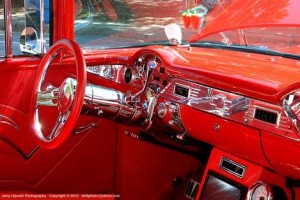
There are so many words in the world, I can’t blame anyone for not knowing the original meaning of any specific word, even when its a simple compound made of two familiar words. We’re so busy using language as a communication tool that we rarely stop hammering to look at the thing itself. A funny old thing, the dashboard.
The most modern use of the word refers to summaries of data on computer screens, which has a pretty clear path extending from the dashboards found inside automobiles. I’ve never really thought about the word ‘dashboard.’ If I had, I imagine I’d assume the ‘dash’ part related to the quick and convenient dials on the board which tell the driver the state of the transmission and oil levels without having to look at the engine itself. “How convenient! One can dash around carefree in a motorcar without having to constantly prop open the old bonnet.”
Not so says actual word history! When humans made the transition from horses to cars, many terms passed from one the other other, creating retronyms. Horsepower is still a standard measurement, while Mustang, Bronco, Pinto, and Colt models all harken back to the previous mode. Horses as transport were so rooted into culture that automobiles were originally referred to as ‘horseless carriages.’ One of the less obvious terms that crossed into cars is ‘dashboard.’
In horseful carriages, dashboards referred to the angled board that kept rocks and mud from ‘dashing’ upon the main part of the vehicle. This use of ‘dash’ relates not to speed, but to falling and splashing, as in the phrases ‘dashed upon the rocks’ and ‘to have one’s hopes dashed.’ Jagged and gashed bubble up in my mind as related terms, most likely from a novel where someone falls off a cliff in the fog.
Maybe this isn’t blowing your mind, but this means that all the fancy gadgets that we value, the auxiliary outlets, the cigarette lighters, the treble adjustment, the seat heaters, all of the buttons, are just the back of the dashboard. It’s like staring at a painting for hours, appreciating its simple beauty, and then turning it over after thirty years to find a copy of the constitution on the back. Dashboards used to be just functional, focused on its defensive capabilities. We now think about the compact visual information at our fingertips, and the entertainment and comfort a car can provide. It is not only a change in basic meaning, but the values attached to it. Fashion changes the outward appearance of clothes, but it always holds the same purpose. The dashboard has kept its location in cars, but completely reversed its outlook, from the exterior to the interior. It is hard to pin down how and when societies change their perspective, the dialogue being disparate and cacophonous. There’s something very satisfying and sweet about a word that has been so transformed while retaining its place in modern life.
May 28, 2011